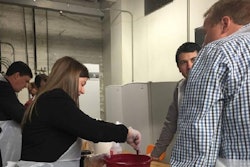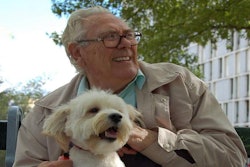The US Midwest is arguably the hub of the global pet food manufacturing industry—specifically, the states of Kansas and Missouri. While you may detect a US, Midwestern bias in that statement (which I must admit to, considering that I grew up and still live in the US Midwest), data backs it up.
That data includes the number of pet food related businesses and organizations located in Kansas and Missouri, not to mention the amount of revenue and market share they generate. For example, Kansas alone is home to 63 animal food manufacturing facilities, 15 of which make dog and/or cat food, according to the 2013 US Economic Census. The 15 facilities employ 1,769 people with an annual payroll of nearly US$83 million.
Those and similar data were highlighted by Steve Kelly, deputy secretary of commerce for Kansas, during the Kansas State University (KSU) Pet Food Experience, which partnered with Petfood Innovation Workshop last week (October 28-30) at KSU. His comments were echoed by Jackie McClaskey, Kansas secretary of agriculture, who said pet food was the fourth largest segment of the state’s US$63 billion agricultural industry (its largest economic sector)—accounting for a total of US$7 billion annually when you look at all of pet food’s efforts and impacts in Kansas.
The secretaries’ main message to attendees was that Kansas is a pet food friendly state, with both explaining ways that their respective agencies work with companies, especially smaller ones, to find financing or incentives, comply with regulations and grow their businesses, including exports. For instance, McClaskey said that 27 pet food companies are licensed by the state’s safe feed/food program, which will likely help them comply with rules under the Food Safety Modernization Act.
But another, equally important message was the size and impact of pet food in the state. That influence spreads to Missouri: of the 300-plus members of the Kansas City Animal Health Corridor, which stretches from Manhattan, Kansas (home of KSU), to Columbia, Missouri, USA (home of the University of Missouri), 31 are pet food manufacturers, suppliers to the industry or similar.
The pet food manufacturers account for 61% of US pet food sales and 49% of global sales, according to the KC Animal Health Corridor’s 2014 Asset Survey. The companies range from a small maker of foods for reptiles and exotic pets, ZuPreem, to facilities for some of the world’s largest pet food companies, including Hill’s Pet Nutrition, Mars Petcare, Nestlé Purina PetCare and its Product Technology Center and Big Heart Pet Brands (with two facilities in Kansas).
Pet food related member companies also include industry suppliers such as Ameri-Pac, Butler Milling, Cargill, Cereal Byproducts Co., Darling International, Land O’ Lakes, Lonza and MGP Ingredients. What’s more, many other significant industry suppliers in segments that don’t fall under animal health and nutrition (the KC Animal Health Corridor’s focus) also call Kansas and Missouri home. That includes equipment manufacturers such as Wenger, Extru-Tech and Schenck Process, as well as service providers like C.J. Foods, a premium, custom pet food manufacturer.
C.J. Foods is likely included in the Kansas pet food manufacturing data, but it deserves special mention because of its focus on and industry reputation for innovation, quality and service—even though it has no pet food brands of its own. In fact, most consumers likely wouldn’t recognize the company name, yet its impact on the pet food market goes beyond its estimated US$175 million in annual sales (2013 data from the Top Pet Food Companies Database).
During the Pet Food Experience, John Kuenzi, former president and CEO of C.J. Foods (and now CEO of Rubicon Scientific), presented his concept of “open incuvation.” Essentially, Kuenzi emphasized, true innovation stems from a focus on collaboration, relationships and partnerships, the basis of that coined term (incuvation). His presentation included several such examples of innovation in pet food, including how C.J. worked with Castor & Pollux Originals (now part of Merrick Pet Care and Nestlé Purina) to develop and make the first certified organic pet food diet on the market. Another case study, outside of his C.J. Foods’ experience, focused on how the Greenies dog treat was conceived and developed. (Kuenzi admitted that he had an opportunity to be part of that concept in the beginning and passed!)
Kathy Gross, PhD, director of global clinical nutrition and claims for Hill’s Pet Nutrition, also addressed pet food innovation. Her unique approach began with a history of pet food product development, going all the way back to the domestication of dogs and cats, through the launching of the first commercial products (1861 for dog food, 1876 for cat food, 1907 for treats with the development of Milk-Bones), through the advent of processing technologies (retort for wet pet food after World War I, extrusion in the 1940s and 1950s), to veterinary medical discoveries (development of the first pet food for sick pets, in 1939), to nutritional discoveries starting in the 1950s and 1960s and continuing on through today.
Of course, no discussion of pet food product development is complete without covering humanization and its impact, which Gross did justice to. That led to mentions of personalization and customization, the next possible frontiers for pet food, though Gross didn’t stop there. Pets—and pet food—in space, anyone?

















